Digital Work Analytics reporting
How Effective is the Pomodoro Technique? Let’s Validate the Productivity Hack
The Pomodoro Technique is one of the most popular productivity hacks around. But how can you tell if it’s working?
The answer: by measuring your workday. And Produce8 helps you do exactly that!
Jump here to let us show you how 👉 How Effective is the Pomodoro Technique?
What is the Pomodoro Technique?
The Pomodoro Technique is a time management method that involves breaking work into focused intervals (typically 25 minutes) known as "Pomodoros" and then following those up with short breaks. It provides a structured approach and regular breaks and is useful for improving productivity, enhancing focus, managing time effectively, and reducing procrastination.
The Pomodoro Technique is simple:
- Prepare a list of tasks you want to accomplish. Have a timer ready.
- Set your timer for 25 minutes. During this time, you'll concentrate solely on a single task.
- When the timer expires, mark one Pomodoro complete and make a note of what you achieved.
- Following this focused session, reward yourself with a five-minute break.
- After completing four Pomodoros, treat yourself to a longer, more rejuvenating break lasting 15-30 minutes.
When to use the Pomodoro Technique
The theory is that the Pomodoro Technique is great for routine work that you don’t want to do. By training yourself to lock in for short periods, you can maintain concentration and complete your task without giving in to distractions.
Such tasks include:
Productivity-enhancing activities:
The Pomodoro Technique can be effective for activities that aim to boost productivity, like organizing, decluttering, or planning. By setting a time limit, you're more likely to stay on track and avoid spending excessive time on these tasks.
Monotonous tasks:
Tasks that are repetitive in nature can benefit from the Pomodoro Technique because it breaks them into manageable time blocks, making them less overwhelming.
Tasks requiring short bursts of focus:
Pomodoro intervals are effective for tasks that demand concentrated attention and focus, such as reading, writing, coding, problem-solving, researching, and studying.
When to avoid the Pomodoro Technique
There are some conditions that are not ideal for the Pomodoro Technique.
Deep work:
The Pomodoro Technique is not designed for deep work . With deep work, you want to get into the flow and fully immerse yourself in a strategic or creative project.
Collaboration:
It’s also not effective for days when there are a lot of meetings or when there are a lot of messages or calls coming in.
Flexible schedules:
Flexible work often involves dealing with varying priorities and ad-hoc tasks. Fixed 25-minute Pomodoro intervals may not accommodate the need to shift quickly between tasks and adapt to changing circumstances.
Distracting environments:
The Pomodoro Technique assumes that individuals have some degree of control over their work environment. In a distracting workplace, factors like noise, interruptions from colleagues, or other external disturbances may be beyond the individual's control, making it difficult to maintain structured intervals.
How effective is the Pomodoro Technique?
To answer this question, we need data — not opinions. Why? Because our working conditions, work styles, and our work itself are unique to us.
Produce8 can provide real-time data and show you how effective your productivity hacks are, including the Pomodoro Technique.
With data from Produce8, you can:
- Measure the efficiency of your workflow
- See focus time and breaks happening during each interval
- See which apps are causing distractions
- Visualize what a successful day looks like and replicate it
Without data, you can only make assumptions about your use of the Pomodoro Technique. When a bad day (or interval) happens, you don’t know what caused it. You won’t be able to make adjustments or improvements. And you won’t know what causes good days, either.
The adage is true: What gets measured, gets managed. To make the most of the Pomodoro Technique, you need to quantify your efforts. Let us help you get started.
Get Produce8:
Though Produce8 is a digital work analytics platform, you can think of it as a health tracker for your workday.
Set up Produce8 , add the main work apps, and access data that will tell you whether you are hitting your goals.
Set baseline:
Before you can determine if the Pomodoro Technique impacts your workday, you need to know what a regular workday looks like. To do that, we recommend working normally—without a Pomodoro timer—for a few days while you acquire data on Produce8.
After that, review your baseline data.
You may be surprised by how often you switch between apps, the number of interactions you have with collaboration tools, and the level of focus you have during work hours.
Make a note of your observations. You will use them as references later on.
Let’s observe my workday as an example. Here is a bad Tuesday for me.
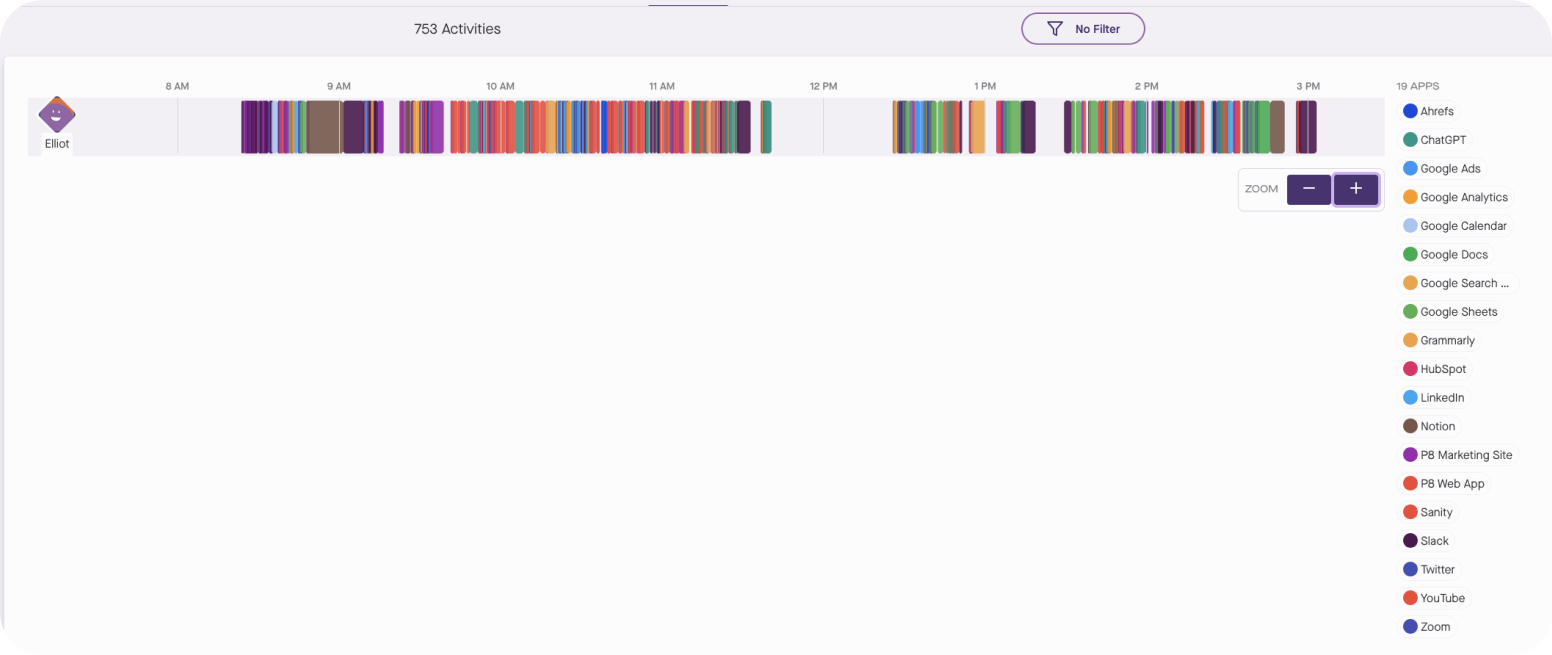
Look at all the apps I’m interacting with!
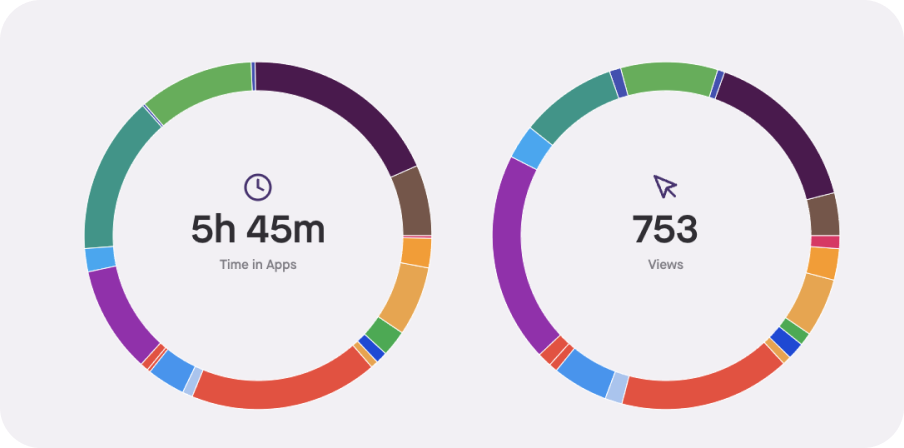
Let’s dive deeper into an app! Specifically one that I am spending way too much time in: Slack! We’re going to examine what my work habits with this app are like.
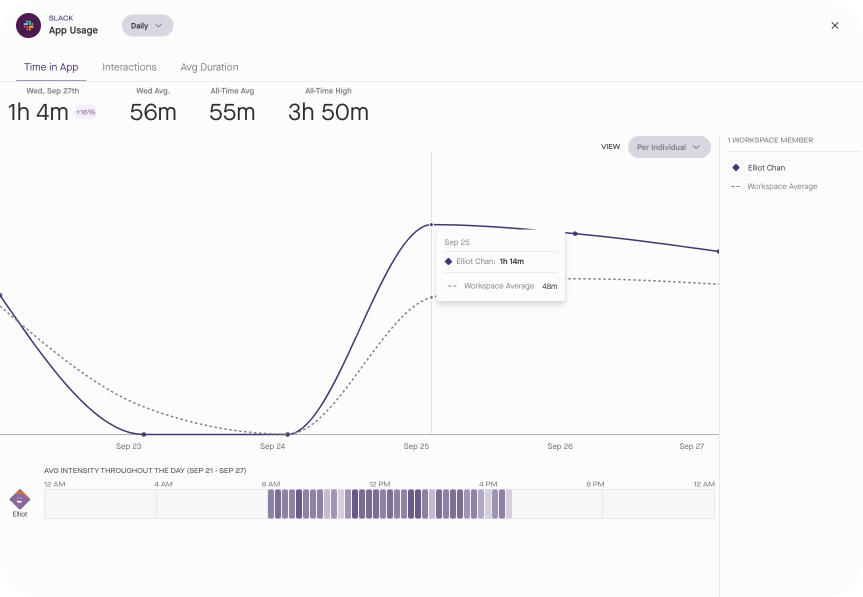
In the Produce8 Trends line graph, notice how my Slack interactions are way higher than the rest of the team’s?

And in the Timeline, see how Slack is distracting me by chopping up my workday into a hundred little segments?
These are areas that can be improved to help with my focus, work efficiency, and digital well-being.
Add a Pomodoro app:
Once you’ve accumulated a few days of baseline data, add your favorite Pomodoro timer to Produce8.
Not sure which Pomodoro timer is best? Here are a few that are quick and easy to use:
Simply connect the Pomodoro timer to Produce8 with the browser extension and start implementing it into your workday:
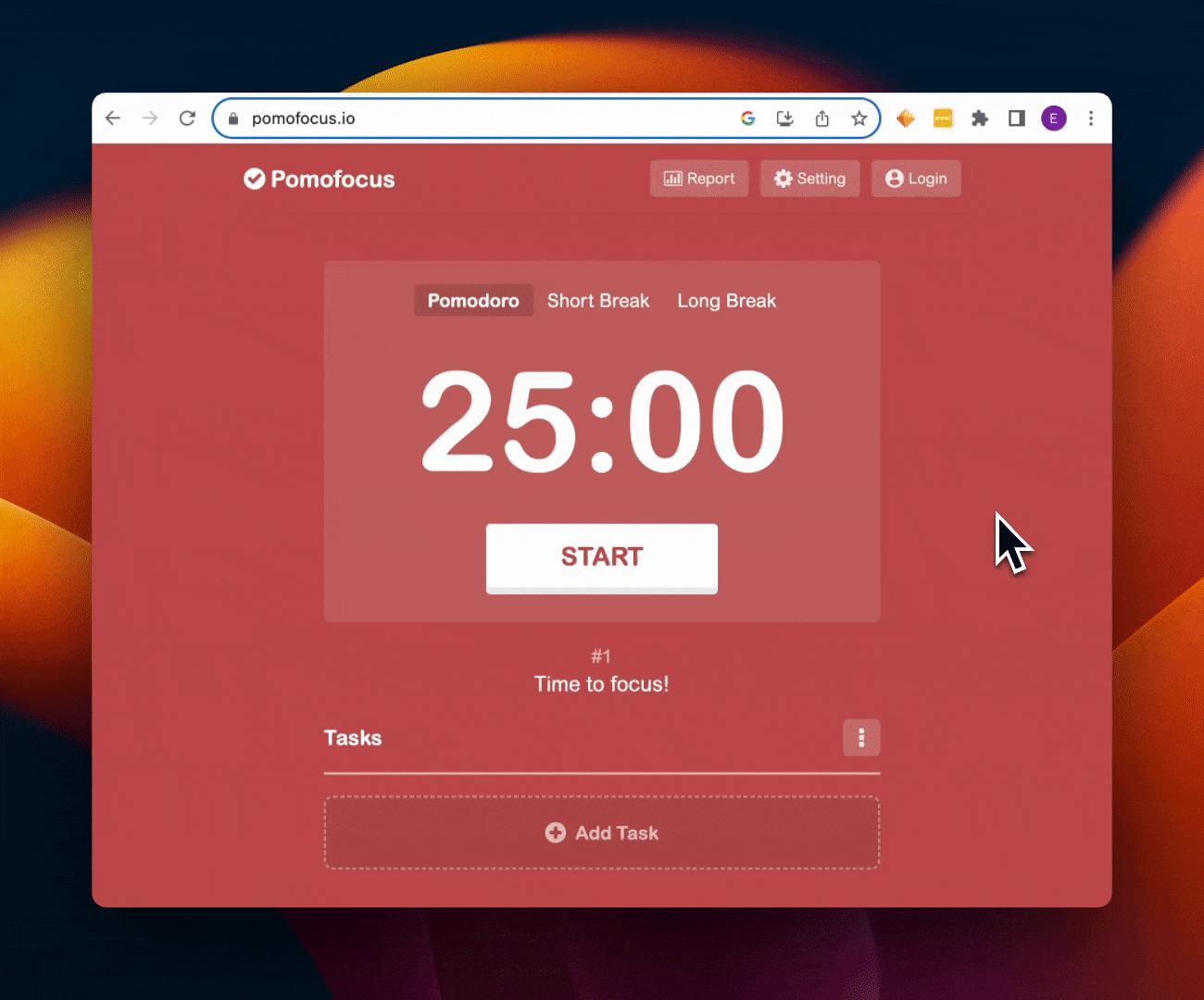
Analyze your results:
After a few days of using the Pomodoro Technique, it’s time to analyze whether it’s working for you.
Here are the questions Produce8 can help you answer regarding your experience with the Pomodoro Technique:
1. Did you increase your focus?
To answer this, go to your Timeline in Produce8 and filter the apps you want to be working in.
Were you spending your Pomodoro intervals working in the app you wanted to be in?

This Timeline shows longer blocks in my preferred work app while working with the Pomodoro Technique.
We can also analyze Focus Scores in the Produce8 Daily Insights section. Did you notice a change in your overall focus?
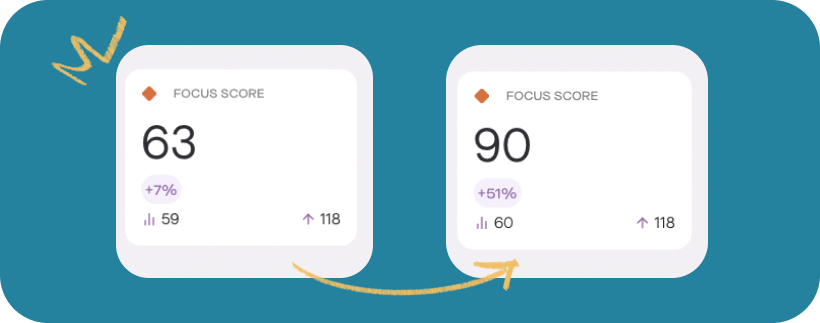
Here you see that my Focus Score went from 63 to 90. That’s a significant improvement!
2. Did you reduce distractions?
Did you spend less time in the applications that distract you?
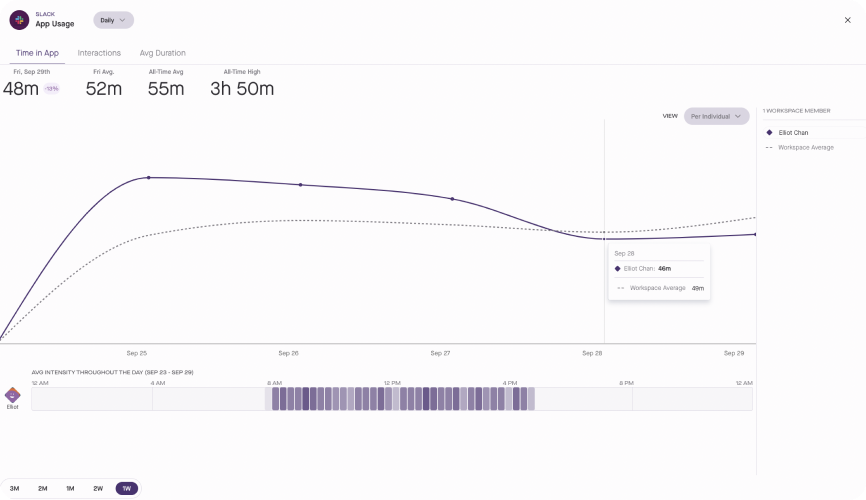
In the Produce8 Trends, I see a reduction in my Slack usage , which got me below the team average.
But to get more clarity, I also want to view the Timeline to see where my interactions with those apps occurred. This will let me know whether I improved my ability to monotask or if was I still multitasking.
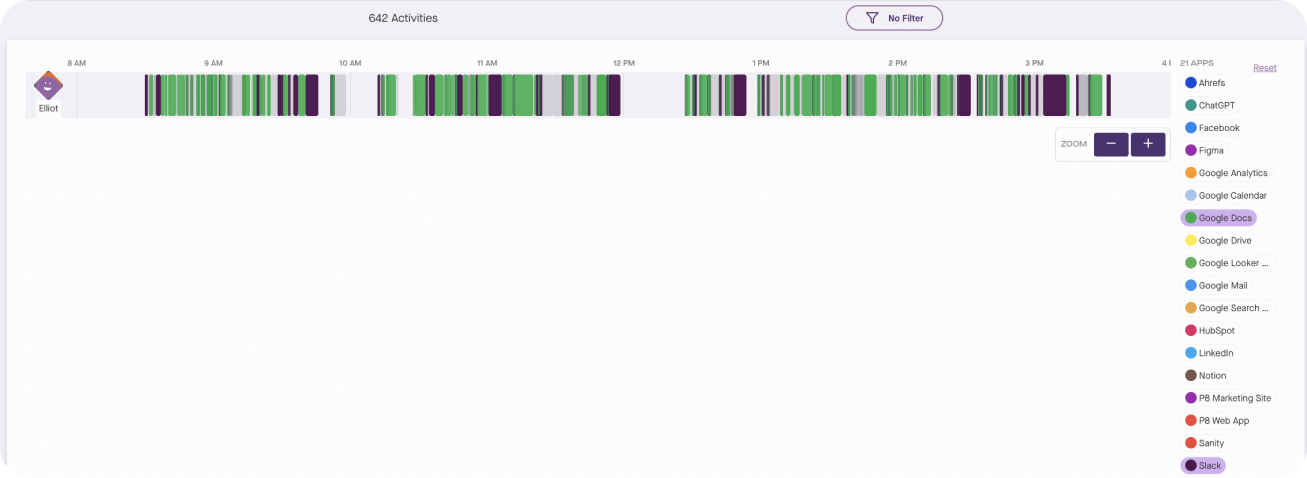
Here we see fewer interactions with other work apps, which are no longer distracting me during my focus blocks.
3. Did your workday improve?
Did the Pomodoro Technique help you regain control of your day and recover lost time? It is our goal at Produce8 to help you regain 90+ minutes of the workday. What you choose to do with that time is up to you.
First, let’s look at breaks. Did you get up from your desk and take a break when you should have?

You can see above that I took my five-minute break.
By starting my timer and turning my computer to sleep mode or minimizing my browser, Produce8 knows that I’m taking a break. Therefore, in the timeline, there will be a gap indicating I was away from my desk.
If you use the Pomodoro Technique, you can see your breaks visible in the timeline.
NOTE: If you leave the Pomodoro timer running on the screen during your break, Produce8 will capture your break as an activity. We recommend minimizing your browser.

Another aspect to look at was my ability to be more efficient at work.
Did the Pomodoro Technique help me make the most of my time?

In the example above, we see that instead of taking my break immediately, I went and checked Slack, responded to some messages, and then took my break afterward.
I deviated from the Pomodoro Technique, but that’s not a bad thing. I was still able to focus on my tasks for 25 minutes before I disconnected to go on Slack. My activity in Slack is therefore longer and more meaningful than my previous scattered interactions. We’ll call that progress!
Next steps! Set a goal:
Now that you know what works for you, set a goal in Produce8 . With a goal, you’ll ensure you’re using the Pomodoro Technique regularly to stay on track.

Conclusion
As you can see, analyzing your workday allows you to properly test different productivity methods that align with your goals. The end result is improvements to your performance and well-being.
If you want to validate whether the Pomodoro Technique works for you, sign up for Produce8 for free. Connect your work tools, start visualizing your workday, and see how the Pomodoro Technique is impacting your work style.
Related Aritcles
Digital Work Analytics reporting
Produce8 Launches Essential Insights: Revolutionizing Digital Work Analytics for Businesses and MSPs
3 min read
Unlock great workdays
Wether you are collaborating with your team or solo tackling your day we can help you recover the most valuable asset, time.
